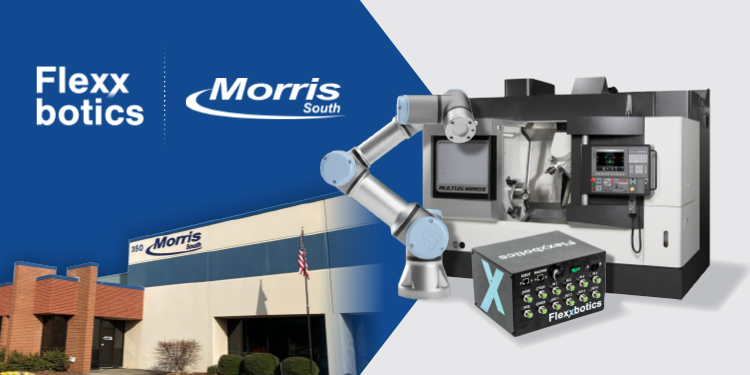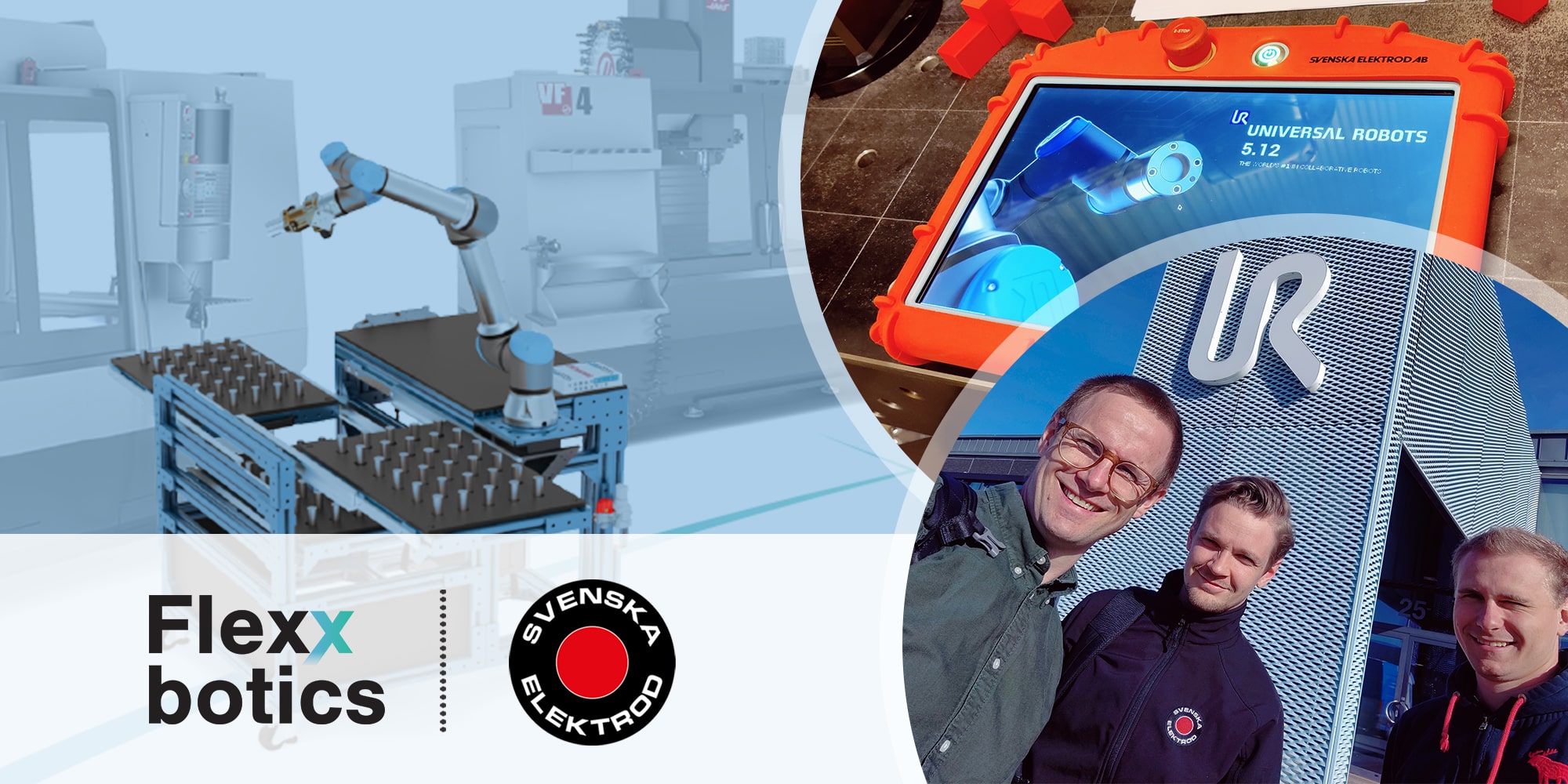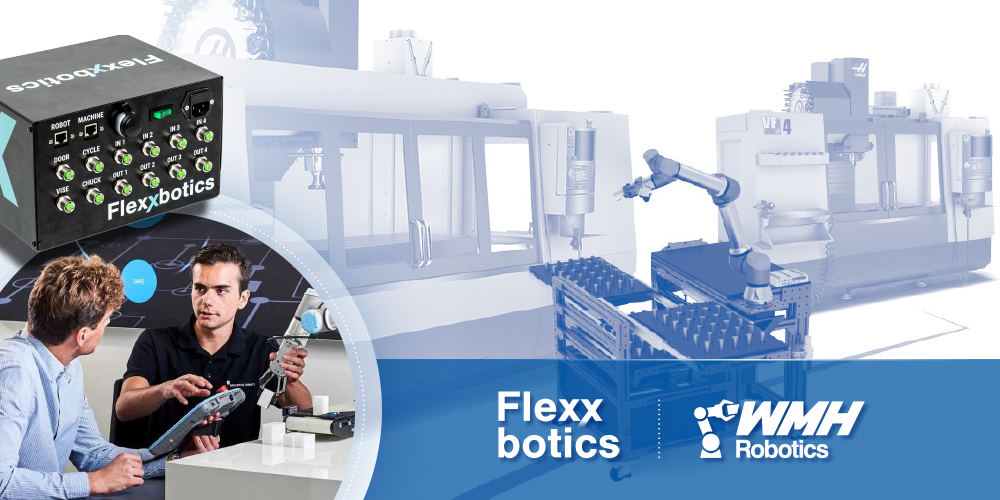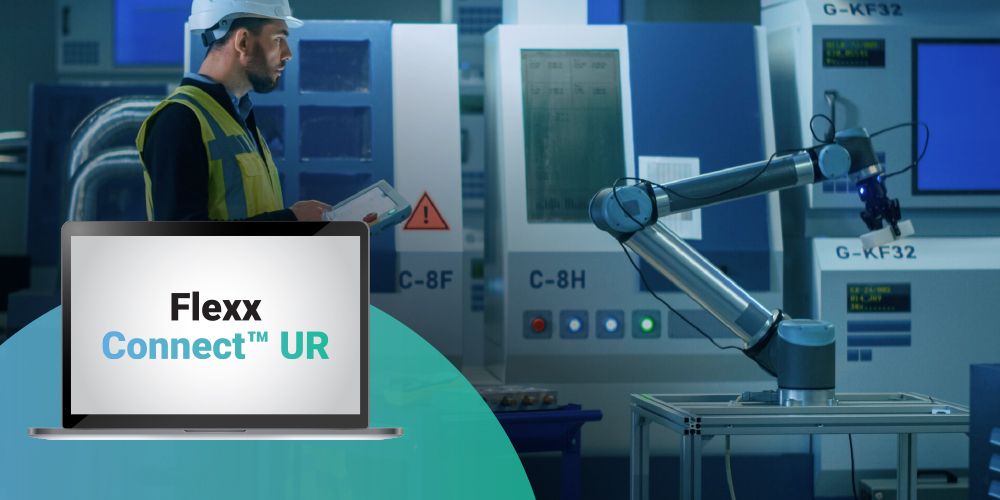
By Flexxbotics: 1/30/2023
Benefits of CNC Machine
Tending Standardization
Standardizing your CNC machine tending interfaces can have several benefits for your manufacturing process. From improving efficiency to reducing downtime, standardization can help your company run more smoothly. In this article, we’ll look at the benefits of standardizing your CNC machine tending interfaces, what you stand to lose by failing to standardize, and other factors you should consider when interfacing a cobot with your CNC machine. By the end of this article, you’ll have a better understanding of how standardization can help you streamline your manufacturing process and future-proof your facility.
What are the Benefits of Standardizing Your CNC Machine Tending Interfaces?
Faster Integration
Standardizing your CNC machine tending interfaces can significantly benefit the integration process, making it faster and more cost-effective. With pre-made software libraries and pre-built hardware available, you can quickly interface a cobot with a CNC machine without starting from scratch. Using a standardized method when integrating a new CNC machine also gives you a clear path forward, saving you time and resources. In addition, standardization simplifies the integration process, allowing you to get your cobot up and running more efficiently. On non-standardized units, integration costs are higher, and timelines are longer.
Simplifies Interfacing with Other CNC Machines
In most facilities, there are a variety of CNC machines in use. For example, multiple brands and various models within brands are typically represented on any manufacturing floor. By using a single standardized platform, you can use the same method to interface with all systems, regardless of whether they are new or legacy equipment. This eliminates the need to figure out a unique approach for each machine, streamlining the process and saving you time and resources. In addition, standardization simplifies interfacing with other CNC robots / machines, making integrating new equipment and maintaining existing systems more accessible.
Easier to Document and Retain Setup Knowledge
As a company grows, knowledge retention around the setup and operations becomes critical for onboarding new operators. With everything labeled, wired, and set up in a standardized way, including the software interface, it is easier for new operators and machinists to understand the system and get up to speed quickly. Standardization also allows for faster cross-training of operators, as they can learn one standardized system rather than multiple variations. This process makes it easier to rotate staff to different machines and maintain flexibility and productivity across your manufacturing floor. Standardization can help you onboard new staff more quickly, cross-train operators faster, and easily rotate staff to various machines. This flexibility is crucial for manufacturers in times of high demand and a thin labor pool.
Knowledge silos characteristic of non-standardized facilities leave manufacturers vulnerable to employee mobility. As engineers, machinists, and operators with specialized machine knowledge leave, so does their knowledge of how to set up, operate, and reconfigure that machine.
Faster Troubleshooting
In addition to easier documentation and knowledge retention, a standard setup makes it easier to identify variations that might be causing issues. This allows you to quickly isolate and fix problems, reducing downtime and improving productivity. Standardization can help you troubleshoot issues faster and more effectively, allowing you to keep your manufacturing process running smoothly.
Difficulty troubleshooting machine issues can lead to extended downtime, lost revenue, and increased frustration among staff. This can negatively impact a manufacturing business in terms of productivity, revenue, and employee morale.
Better Support and Knowledge Retention with the Interface
How quickly your operators and machinists can get up to speed with your CNC machine tending systems can be a significant challenge when interfaces aren’t standardized. In addition, if your system integrator or engineer is no longer working on the project or leaves, it can be difficult to determine how the previous integrator set up each machine. This knowledge gap ultimately leads to revenue loss due to increased downtime.
Standardization helps to eliminate these knowledge gaps, making it easier to retain interfacing knowledge and maintain your systems. Additionally, working with a third-party interfacing company, such as Flexxbotics, can provide additional support and standardization to help with the setup and future maintenance of your CNC machine tending system. Standardization can help you retain knowledge and ensure that you have a reliable source of support for your machine interface.
Simpler Remote Support
A standardized system lets you know exactly what the setup should look like on any machine, regardless of where you are located. This makes providing remote support for your machines easier and helps ensure that your manufacturing process stays running smoothly, even when you are not physically present on site. In addition, remote capabilities allow manufacturers to save on travel costs for themselves or the integrators they use for support.
Did you know that Flexxbotics provides remote support? Reach out to us today to learn how we can provide world class service remotely for our automation systems.
Simplified Maintenance and Updates
Standardizing your CNC machine tending interfaces makes it easier to perform maintenance and updates. With standardization, you can follow the same instructions for all machines, rather than creating and following different procedures for each one. This saves time and resources and helps keep your manufacturing process running with minimal downtime required for regular maintenance and software updates.
Easier to Standardize on Processes and Instructions
Standardizing hardware and software should lend itself to standardizing operator processes and workflows. Standardization can be incredibly beneficial for several reasons.
First, it helps to streamline the manufacturing process, making it more efficient and consistent. By having a standardized set of processes and workflows, operators can easily follow the same steps to complete tasks, eliminating the need to learn multiple variations. This systematic approach can reduce errors and improve the overall quality of the finished product.
In addition, standardization can also help to improve operator training and onboarding, as there is a clear set of procedures to follow. Without standardization, manufacturers may have to deal with multiple variations of processes and workflows, leading to confusion and a higher risk of errors.
Simpler Regulatory Compliance
Certain industries require specific documentation for regulatory compliance. A standardized system and set of instructions can remove a layer of complexity when meeting these requirements. With a standardized system in place, you can easily follow the same set of procedures and documentation requirements across all of your machines. This can be particularly helpful when processes need to be changed frequently, as it eliminates the need to create and follow separate procedures for each machine. Standardization can help manufacturers streamline their compliance efforts and make it easier to meet regulatory requirements across multiple machines.
Streamlined Re-deployment to Other CNC Machines
With standardized setups, it’s easier and faster to move cobots to new CNC machines. This mobility is important because production requirements can change, and machines can go down for scheduled service or unexpected reasons. The ability to move your CNC machine tending robots easily can be a huge benefit. Standardization can ensure that re-deployment is fast, simple, and minimizes downtime, helping you keep operations running even when facing unexpected situations. Other manufacturers will be tied to systems that they can’t move around flexibly as needed—leaving them stranded when CNC issues occur.
Reduce Errors and Oversight
When you have a standardized system in place, you can streamline your operations and eliminate common mistakes that might occur due to setup variations. This can help you maintain optimal levels of quality control. Poor quality control leads to increased part failures and wasted material–resulting in reduced profits.
If you are looking for a system to help you track performance and give you the tools to optimize and continually improve your workcell, check out FlexxConnect™ here.
Easier Scalability
One of the primary benefits is the ability to scale production more quickly. Adding additional CNC machines to your production line becomes much more straightforward when you have a standardized system. This is because you have already established a standardized integration, setup, and control process, so you don’t have to worry about the complexity, increased costs, and ramp-up time of one-off setups for each new machine.
In addition, you can easily copy previously proven systems to scale out production to meet increasing demand for your products. Overall, standardizing CNC machine tending can help manufacturers to be more agile and responsive to changes in the market.
Other Factors that You Should Consider when Interfacing a Cobot with Your CNC
Standardizing your CNC machine tending solutions can provide a range of benefits that can help your manufacturing business to run more smoothly and efficiently. Some additional benefits may include:
Upskilling Current CNC Machine Operators and Machinists
By using a standardized platform like FlexxCNC™, you can make it easier for your current CNC operators to learn how to operate the CNC machine tending setup. Furthermore, you might find your machinists able to take on tasks typically reserved for engineers. By upskilling your existing workforce, you enable them to be more versatile, which can improve the overall efficiency of your manufacturing process.
Loading G-Code and Macros into Memory
The FlexxCNC™ system allows you to load g-code programs and macros into memory on the CNC machine, which can help streamline your CNC machines’ operation. For example, this can make it easier for machinists to run multi-op and real-time offsets on their CNC machine directly through the cobot system without altering their g-code.
Running your CNC Machine Lights Out
With the FlexxCNC™ system, you can automate all aspects of your CNC machines, including the execution of g-code, the actuation of vises, chucks, and doors, and the initiation of stop/start/wait cycles. This can help you to run your CNC machines lights out, which can increase the efficiency of your manufacturing process and reduce the need for human intervention.
Do you want to streamline your operations and improve the efficiency of your manufacturing process? Our FlexxCNC™ system is a standardized platform that makes it easy to integrate, set up, and control CNC machines. Our team of experts is here to support you every step of the way. So don’t let the complexity of automated CNC machine tending hold you back. Contact Flexxbotics today to learn more about how we can help you standardize your CNC machine tending solutions and take your manufacturing business to the next level.
Contact us today to get started.
Suggested Articles

Flexxbotics Partners with Morris South
12/13/2022

Flexxbotics Partners with Svenska Elektrod
10/14/2022

Flexxbotics and WMH Robotics Partnership
9/27/2022

FlexxConnect™ UR Product Launch
11/3/2022

